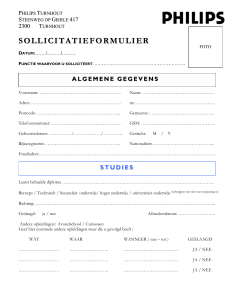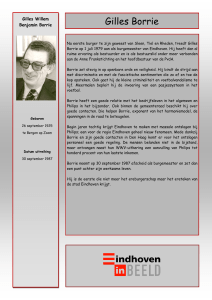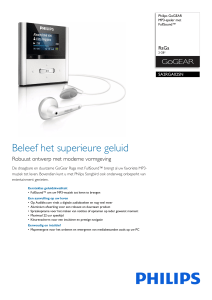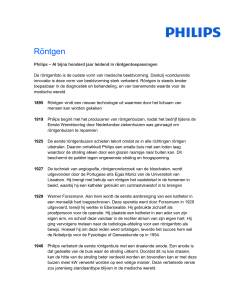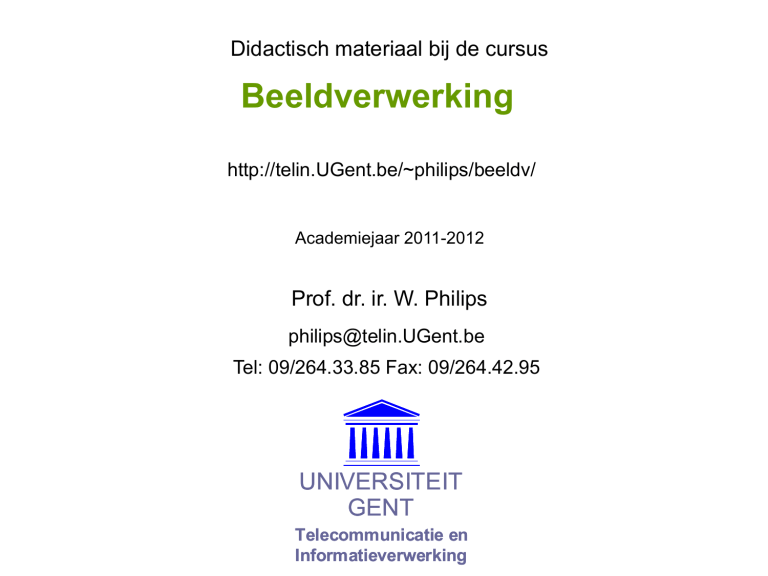
Didactisch materiaal bij de cursus
Beeldverwerking
http://telin.UGent.be/~philips/beeldv/
Academiejaar 2011-2012
Prof. dr. ir. W. Philips
[email protected]
Tel: 09/264.33.85 Fax: 09/264.42.95
UNIVERSITEIT
GENT
Telecommunicatie en
Informatieverwerking
versie: 5/10/2011
© W. Philips, Universiteit Gent, 1998-2012
Copyright notice
This powerpoint presentation was developed as an educational aid to the renewed course “Image processing” (Beeldverwerking), taught at the University of Gent, Belgium as
of 1998.
This presentation may be used, modified and copied free of charge for non-commercial purposes by individuals and non-for-profit organisations and distributed free of charge
by individuals and non-for-profit organisations to individuals and non-for-profit organisations, either in electronic form on a physical storage medium such as a CD-rom,
provided that the following conditions are observed:
1. If you use this presentation as a whole or in part either in original or modified form, you should include the copyright notice “© W. Philips, Universiteit Gent, 19982001” in a font size of at least 10 point on each slide;
2. You should include this slide (with the copyright conditions) once in each document (by which is meant either a computer file or a reproduction derived from such a
file);
3. If you modify the presentation, you should clearly state so in the presentation;
4. You may not charge a fee for presenting or distributing the presentation, except to cover your costs pertaining to distribution. In other words, you or your organisation
should not intend to make or make a profit from the activity for which you use or distribute the presentation;
5. You may not distribute the presentations electronically through a network (e.g., an HTTP or FTP server) without express permission by the author.
In case the presentation is modified these requirements apply to the modified work as a whole. If identifiable sections of that work are not derived from the presentation, and
can be reasonably considered independent and separate works in themselves, then these requirements do not apply to those sections when you distribute them as separate
works. But when you distribute the same sections as part of a whole which is a work based on the presentation, the distribution of the whole must be on the terms of this
License, whose permissions for other licensees extend to the entire whole, and thus to each and every part regardless of who wrote it. In particular note that condition 4 also
applies to the modified work (i.e., you may not charge for it).
“Using and distributing the presentation” means using it for any purpose, including but not limited to viewing it, presenting it to an audience in a lecture, distributing it to
students or employees for self-teaching purposes, ...
Use, modification, copying and distribution for commercial purposes or by commercial organisations is not covered by this licence and is not permitted without the author’s
consent. A fee may be charged for such use.
Disclaimer: Note that no warrantee is offered, neither for the correctness of the contents of this presentation, nor to the safety of its use. Electronic documents such as this
one are inherently unsafe because they may become infected by macro viruses. The programs used to view and modify this software are also inherently unsafe and may
contain bugs that might corrupt the data or the operating system on your computer.
If you use this presentation, I would appreciate being notified of this by email. I would also like to be informed of any errors or omissions that you discover. Finally, if you have
developed similar presentations I would be grateful if you allow me to use these in my course lectures.
Prof. dr. ir. W. Philips
Department of Telecommunications and Information Processing
University of Gent
St.-Pietersnieuwstraat 41, B9000 Gent, Belgium
E-mail: [email protected]
Fax: 32-9-264.42.95
Tel: 32-9-264.33.85
01b.2
Enkele karakteristieken
van het menselijk visueel systeem
versie: 5/10/2011
© W. Philips, Universiteit Gent, 1998-2012
Inleiding
Beelden zijn dikwijls bedoeld om door mensen te worden bekeken
Beeldverwerking wijzigt beelden,
•gewild: b.v. beeldverbetering
•of ongewild: b.v. compressie
Het is dus belangrijk om te weten hoe de mens afwijkingen in beelden
waarneemt
Het menselijk visueel systeen is uiterst complex; het bestaat uit
•het oog: een sensor met lokale signaalverwerking (“preprocessing”)
•de visuele cortex: lage- en hoge-niveau beeldverwerking
•de rest van het brein: interpretatie
Al deze deelsystemen beïnvloeden elkaar!
Hopeloos complex!
01b.4
versie: 5/10/2011
© W. Philips, Universiteit Gent, 1998-2012
Optische illusies
http://www.youtube.com/watch?v=WvVfcyVCdNA
http://www.unoriginal.co.uk/illusionvideos.html
http://www.viscog.com
01b.5
versie: 5/10/2011
© W. Philips, Universiteit Gent, 1998-2012
Helmholtz
Stripes or hoops? Fashion myth
uncovered
By Steve Connor
Friday, 12 September 2008
The first rule of fashion – that
vertical stripes flatter the figure
– is a myth, according to a study
conducted by scientists at York
University.
Women who avoid wearing clothes
with horizontal stripes in the
belief that it makes their bum
look larger should be reassured
by a scientific study showing
quite the opposite. It found that
horizontal stripes actually make
people look slimmer.
http://http://www.belfasttelegraph.co.uk/lifest
yle/fashion-beauty/stripes-or-hoops-fashionmyth-uncovered-13972416.html
01b.6
versie: 5/10/2011
© W. Philips, Universiteit Gent, 1998-2012
Golflengte en frequentie
01b.7
versie: 5/10/2011
© W. Philips, Universiteit Gent, 1998-2012
Vermogenspectrum van licht
x
Opmerking: zichtbaar licht
I(x,y) dS
y
550 nm (grootteorde)
f 500 THz (grootteorde)
Lichtintensiteit: I(x,y)d S is het lichtvermogen dat invalt op een
elementair stukje oppervlak d S (eenheid: Watt/m2)
Licht kan worden ontbonden in een kleurenspectrum
I ( x, y )
I ( x, y; f ) df
frequentiespectrum
(onafhankelijk van het
transmissiemedium)
df
I ( x, y; c / )
d
d
I ' ( x, y; ) d
golflengtespectrum
(gebruikt in de lichttechnologie)
In de vrije ruimte: f =c met c de lichtsnelheid
df
c
2
d
01b.8
versie: 5/10/2011
© W. Philips, Universiteit Gent, 1998-2012
Structuur van het menselijk oog
lens
retina
visuele as
blinde
vlek fovea
optische
zenuwbundel
Staafjes en kegeltjes
Fotogevoelige elementen in de retina:
•twee soorten: kegeltjes en staafjes
•grootste dichtheid in de fovea
•100.000.000 receptoren in het oog maar
slechts 800.000 zenuwdraden
er is duidelijk lokale processing in het oog
Kegeltjes
•aantal: 6.000.000
•voor zicht bij normaal omgevingslicht
•3 types, gevoelig voor respectievelijk
blauw, groen en geelgroen licht
Staafjes
•aantal: 100.000.000
voor
•veel gevoeliger dan
kegeltjes
“donker”-zicht
•1 type geen kleuronderscheiding
01b.9
versie: 5/10/2011
© W. Philips, Universiteit Gent, 1998-2012
Retina, kegeltjes en staafjes
Zenuwbundels
01b.10
versie: 5/10/2011
© W. Philips, Universiteit Gent, 1998-2012
De neurale interconnecties in het oog
amacriene cel
bipolaire cel
Bipolaire cellen:
•input=kegeltjes
•output=ganglioncellen
Horizontale cellen
•maken dwarsverbindingen tussen kegeltjes en bipolaire cellen
Amacriene cellen:
•maken dwarsverbindingen tussen bipolaire
cellen en ganglion
cellen
horizontale cel
01b.11
versie: 5/10/2011
© W. Philips, Universiteit Gent, 1998-2012
Absorptiespectra van kegeltjespigmenten
Deze absorptiespectra geven aan hoeveel percent van het licht op een
bepaalde frequentie in de kegeltjes wordt geabsorbeerd
Dit licht wordt echter niet volledig omgezet in een zenuwsignaal
De absorptiespectra geven slechts een ruw idee van de spectrale
gevoeligheid van de kegeltjes
arbitraire eenheden
relatieve absorptiespectra
(golflengtespectra!)
b (groen)
g (geelgroen
tot rood)
(blauw)
400
500
600
golflengte (nm)
700
01b.12
versie: 5/10/2011
© W. Philips, Universiteit Gent, 1998-2012
Spectrale gevoeligheid van de kegeltjes...
Wat is het verband tussen het invallend lichtspectrum I ( f ) en de
zenuwsignalen “aan de uitgang” van de kegeltjes?
Experimentele vaststelling: goed model voor de respons van een kegeltje
van type i op licht met spectrum I(f): f(ri ) met ri Si ( f ) I ( f ) df
met • Si( f ), i=1,2,3 de spectrale gevoeligheid van de kegeltjes van type i
• f (x) c log(x): een monotoon stijgende “log”-achtige functie
De spectrale gevoeligheidscurve geeft weer hoeveel van het licht met een
bepaalde frequentie in een elektrisch signaal wordt omgezet
De log-functie zorgt voor dynamiekcompressie (sterkte daglicht kan met
een factor 20 000 variëren)
01b.13
versie: 5/10/2011
© W. Philips, Universiteit Gent, 1998-2012
… Spectrale gevoeligheid van de kegeltjes...
Verschil spectrale gevoeligheid en absorptiekarakteristiek:
•De spectrale gevoeligheidscurve Si( f ) geeft weer hoeveel van het licht
met een bepaalde frequentie in een elektrisch signaal wordt omgezet
•De absorptiekarakteristiek Ai( f ) geeft aan hoeveel licht bij een bepaalde
frequentie wordt geabsorbeerd
Verband: Si ( f ) Ai ( f ) Ei ( f )
Ruwe benadering: Si( f ) Ai( f )
I( f )
Absorptie
Ai(f)
ri Si ( f ) I ( f ) df
fotonen
elektronen
Efficiëntie Ei(f)
Spectraal filter/fotocel
log()
f(ri )
Dynamiekcompressie
01b.14
versie: 5/10/2011
© W. Philips, Universiteit Gent, 1998-2012
...Spectrale gevoeligheid van de kegeltjes
Ruwe benadering voor Si’( ): Si’() Ai’( )
b (groen)
g (geelgroen
tot rood)
(blauw)
400
500
600
golflengte (nm)
700
Conclusies:
• Het oog is weinig gevoelig voor blauw
• De gevoeligheidscurven overlappen vrij veel zelfs bronnen met een
smal spectrum zullen meestal meerdere types kegeltjes activeren
Opmerking: Si’() =Si (c/)
01b.15
versie: 5/10/2011
© W. Philips, Universiteit Gent, 1998-2012
Metamerisme
relatieve absorptiespectra
b (groen)
g (geelgroen
tot rood)
(blauw)
bron2
bron1
400
500
600
700
golflengte (nm)
Metamerisme: bronnen met een verschillend spectrum kunnen de zelfde
kleurindruk geven (de mens ziet geen verschil tussen de bronnen)
Logisch: I( f ) is een functie en dus bepaald door oneindig veel getallen
en er zijn maar drie soorten kegeltjes er gaat informatie verloren
Er bestaan minder triviale voorbeelden van metamerisme (zie appendix!)
01b.16
versie: 5/10/2011
© W. Philips, Universiteit Gent, 1998-2012
De wet van Weber...
Kleinst waarneembaar contrast:
(grijs licht)
I
I I
I / I 0.02
I
I
(Weber’s wet)
2%
Intensiteit I
Deze experimenteel vastgestelde wet
suggereert een logaritmisch verband
tussen de “waargenomen helderheid” I’
en de opgenomen lichtintensiteit I:
I ' 1 I 0.02 I
I '
1
I ' 50 ln( I ) b
I 0.02 I
I ' a log( I ) b
Alhoewel een logaritmisch verband het
experiment grotendeels kan verklaren
blijkt dat de werkelijkheid veel complexer
is en dat de “waargenomen helderheid” I’
in een punt ook afhangt van de
lichtintensiteit in andere kegeltjes
01b.17
versie: 5/10/2011
© W. Philips, Universiteit Gent, 1998-2012
...De wet van Weber
Kleinst waarneembaar contrast tussen 2 lichtvlekken op een achtergrond
Besluit:
I0
I I
I
I / I 0.02 f I I 0
I 0 C1
I 0 C2
I
I
•Weber’s wet gaat maar op als II0
•Intensiteitsverschillen tussen twee gelijkende
lichtintensiteiten I en I+I zijn moeilijker waar
te nemen als de intensiteit I0 van
achtergrondlicht sterk verschilt van I
•de waargenomen helderheid van een punt
hangt ook af van de lichtintensiteit in andere
punten
Verklaring:
•het oog past zich aan het achtergrond-licht
(omgevingslicht) aan
•cfr. verblinding door de zon
Intensiteit I
01b.18


